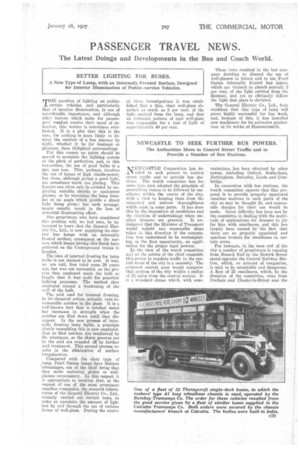PASSENGER TRAVEL NEWS.
Page 61

If you've noticed an error in this article please click here to report it so we can fix it.
The Latest Doings and Developments in the Bus and Coach World.
BETTER LIGHTING FOR BUSES.
A New Type of Lamp, with an Internally Frosted Surface, Designed for Interior Illumination of Public-service Vehicles. •
T"question of lighting on publie. service vehicles, and particularly that of interior Illumination, is one of considerable importance, and although other factors which make for passengers' comfort receive their ineed of attention, this matter is sometimes overlooked. It is a pity that this is the case, for nothing is more likely to destroy the comfort of a bus journey by night, whether it be for business or pleasure, than ill-lighted surroundings.
For this reason no pains should be spared to maintain the lighting system at the pitch of perfection, and, in this con uection, the use of good bulbs is a sine qua. non, . This, perhaps, involves the uso of lamps of high candle-power, but these, although giving a good light, are sometimes much too glaring. This feature can often only be avoided by employing suitable shields or opalescent glasses, or by mounting the lamp bracket at an angle which avoids a direct light being given; but such arrangemeats usually result in the loss of potential illuminating effect.
Bus proprietors who have considered this problem will, we feel sure, he interested to learn that the General Electric Co., Ltd., is now supplying its electric bus lumps with an internally frosted surface, consequent on the success which lamps having this finish have achieved on the Underground trains in London.
The idea of internal frosting for lamp bulbs is not claimed to he new. It was, we are told, first tried some 20 years ago, but was not successful, as the process then employed made the bulb so fragile that it was unfit for practical lighting purposes. The method then employed caused a weakening of the wall of the bulb.
The acid used for internal frosting, by its chemical action, actually cuts inoumerabla notches in the glass. It is a well-known fact that a notched metal bar increases in strength when the notches are filed down until they disappear. In the new process of internally frosting lamp bulbs, a principle closely resembling this is now employed. Just as filed notches are eradicated by hie treatment, so the sharp grooves cut by the acid are rounded off by further acid treatment. This second process resuits in the elimination of surface irregularities.
Compared with the clear type of lamp, Pearl Osram lamps leave distinct 'advantages, one of the chief being that they make enclosing globes or wellglasses unuecessary. In this respect it is appropriate to mention that, at the request of one of the most prominent omnibus companies, the research laboratories of the General Electric Co., Ltd., recently carried out certain tests, in order to ascertain the amount of light lost by and through the use of various forms of well-glass. During the course of these investigations it was e'stablisted that a thin, clear well-glass absorbed as much as 8 per cent, of the light emitted from the lamp, and that an elaborate pattern of opal well-glass was responsible for a loss of light of approximately 40 per cent. These tests resulted in the bus company deciding to discard the use of well-glasses in future and to use Pearl Gsram internally frosted bus lamps, which are claimed to absorb scarcely 2 per cent, of the light emitted from the filament, and yet so efficiently diffuse the light that glare is obviated.
The General Electric Co., Ltd., feels confident that this type of lamp will prove highly successful for bus work, and, because of this, it has installed new machinery far its extensive pa-oduetion at its works at Hammersmith.












































































































